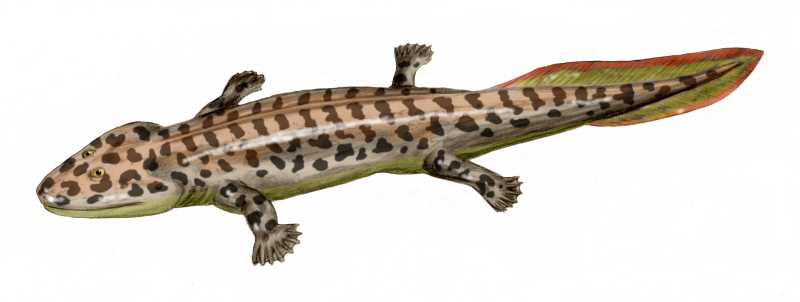- Acanthostega
Taxobox
name = "Acanthostega"
fossil_range = Fossil range|365LateDevonian

image_width = 250px
image_caption = restoration of "Acanthostega gunnari"
regnum =Animal ia
phylum = Chordata
superclassis =Tetrapoda
familia = Acanthostegidae
genus = "Acanthostega"
species = "A. gunnari"
binomial = "Acanthostega gunnari"
binomial_authority = Jarvik, 1952"Acanthostega" is an extinct
tetrapod genus, among the first vertebrate animals to have recognizable limbs. It appeared in the UpperDevonian (Famennian) about 365 million years ago, and was anatomically intermediate betweenlobe-finned fish es and the first tetrapods fully capable of coming onto land.Jennifer A. Clack , "Scientific American", [http://sciam.com/print_version.cfm?articleID=000DC8B8-EA15-137C-AA1583414B7F0000 "Getting a Leg Up on Land"] Nov. 21, 2005.]Description
It had eight digits on each hand and foot linked by webbing, it lacked wrists, and was generally poorly adapted to come onto land. "Acanthostega" also had a remarkably fish-like shoulder and forelimb. [" [http://www.devoniantimes.org/Order/re-acanthostega.html Acanthostega gunneri] ," "Devonian Times".] The front foot of "Acanthostega" could not bend forward at the elbow, and thus could not be brought into a
weight bearing position, appearing to be more suitable for paddling or for holding on to aquatic plants. It had lungs, but its ribs were too short to give support to its chest cavity out of water, and it also had gills which were internal and covered like those of fish, not external and naked like those of some modern amphibians which are almost wholly aquatic.Therefore,
paleontologist s surmise that it probably lived in shallow, weed-choked swamps, the legs having evolved for some other purpose than walking on land.Jennifer A. Clack interprets this as showing that this was primarily an aquatic creature descended from fish that had never left the sea, and that tetrapods had evolved features which later proved useful for terrestrial life, rather than crawling onto land and then gaining legs and feet as had previously been surmised. At that period, for the first time,deciduous plants were flourishing and annually shedding leaves into the water, attracting small prey into warm oxygen-poor shallows that were difficult for larger fish to swim in. Clack remarks on how the lower jaw of "Acanthostega" shows a change from the jaws of fish which have two rows of teeth, with a large number of small teeth in the outer row, and two large fangs and some small teeth in the inner row. It differs, having a small number of larger teeth in the outer row and smaller teeth in the inner row, and she suggests that this change probably went with a shift in early tetrapods from feeding exclusively in water to feeding with the head above water or on land.Research based on analysis of the suture morphology in its skull indicates that the species may have bitten directly on prey at or near the water's edge. Markey and Marshall compared the skull with the skulls of fish, which use suction feeding as the primary method of prey capture, and creatures known to have used the direct biting on prey typical of terrestrial animals. Their results indicate that "Acanthostega" was adapted for what they call terrestrial-style feeding, strongly supporting the hypothesis that the terrestrial mode of feeding first emerged in aquatic animals. If correct, this shows an animal specialized for hunting and living in shallow waters in the line between land and water. [ [http://www.pnas.org/cgi/content/abstract/104/17/7134 Terrestrial-style feeding in a very early aquatic tetrapod is supported by evidence from experimental analysis of suture morphology] , Molly J. Markey and Charles R. Marshall, PNAS April 16, 2007. Retrieved
2007-07-18 ]Discovery
The
fossilized remains are generally well preserved, with the famousfossil by which the significance of this species was discovered being found byJennifer A. Clack in EastGreenland in 1987, though fragments of the skull had been discovered in 1933 byGunnar Säve-Söderbergh andErik Jarvik .Related species
" – exhibited a sequence of adaptations:
- "
Panderichthys ", suited to muddy shallows; - "
Tiktaalik " with limb-like fins that could take it onto land; - Early tetrapods in weed-filled swamps, such as:
- "Acanthostega" which had feet with eight digits,
- "
Ichthyostega " with limbs.
coelacanth species.] "Acanthostega" is seen as part of widespread speciation in the late Devonian period, starting with purely aquatic lobe-finned fish, with their successors showing increased air breathing capability and related adaptions to the jaws and gills, as well as more muscular neck allowing freer movement of the head than fish have, and use of the fins to raise the body of the fish. These features are displayed by the earlier "Tiktaalik ", which like the "Ichthyostega " living around the same time as "Acanthostega" showed signs of greater abilities to move around on land, but is thought to have been primarily aquatic.Sources
*http://tolweb.org/tree?group=Acanthostega&contgroup=Terrestrial_Vertebrates
*http://www.palaeos.com/Vertebrates/Units/150Tetrapoda/150.150.html#Acanthostega
*http://faculty.uca.edu/~benw/biol4402/lecture8c/sld004.htm
*http://gatito.valdosta.edu/fossil_pages/fossils_dev/a1.html
*http://faculty.evansville.edu/de3/b39903/PDFs/12_Land_InvasionII.pdf
*http://www.wfiu.indiana.edu/amos/library/scripts/acanthostega.html- "
Wikimedia Foundation. 2010.
